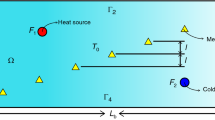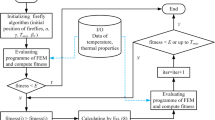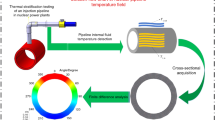Abstract
The interfacial heat transfer coefficient (IHTC) is one of the most important thermal physical parameters which have significant effects on the calculation accuracy of physical fields in the numerical simulation. In this study, the artificial fish swarm algorithm (AFSA) was used to evaluate the IHTC between the heated sample and the quenchant in a one-dimensional heat conduction problem. AFSA is a global optimization method. In order to speed up the convergence speed, a hybrid method which is the combination of AFSA and normal distribution method (ZAFSA) was presented. The IHTC evaluated by ZAFSA were compared with those attained by AFSA and the advanced-retreat method and golden section method. The results show that the reasonable IHTC is obtained by using ZAFSA, the convergence of hybrid method is well. The algorithm based on ZAFSA can not only accelerate the convergence speed, but also reduce the numerical oscillation in the evaluation of IHTC.

















Similar content being viewed by others
References
Beck JV, Blackwell B, St. Clair CR (1985) Inverse heat conduction, ill-posed problems. A Wiley-Interscience Publication, New York
Gu JF, Pan JS, Hu MJ (1998) Inverse heat conduction analysis of synthetical surface heat transfer coefficient during quenching process. J Shanghai Jiaotong Univ 32:18–22
Li HP, He LF, Zhang CZ et al (2015) Research on the effect of boundary pressure on the boundary heat transfer coefficients between hot stam** die and boron steel. Int J Heat Mass Tran 91:401–415
Hu P, Ying L, Li Y et al (2013) Effect of oxide scale on temperature-dependent interfacial heat transfer in hot stam** process. J Mater Process Tech 213(9):1475–1483
Wang HM, Yu W, Cai QW (2012) Experimental study of heat transfer coefficient on hot steel plate during water jet im**ement cooling. J Mater Process Tech 212(9):1825–1831
Li HP, Zhao GQ, Niu ST et al (2006) Inverse heat conduction analysis of quenching process using finite-element and optimization method. Finite Elem Anal Des 42(12):1087–1096
Luo X, Yang Z (2017) A new approach for estimation of total heat exchange factor in reheating furnace by solving an inverse heat conduction problem. Int J Heat Mass Tran 112:1062–1071
Ilkhchy AF, Jabbari M, Davami P (2012) Effect of pressure on heat transfer coefficient at the metal/mold interface of A356 aluminum alloy. ☆ Int Commun Heat Mass 39(5):705–712
Li HP, He LF, Zhang CZ et al (2016) Solution of boundary heat transfer coefficients between hot stam** die and cooling water based on FEM and optimization method. Heat Mass Transf 52:805–817
Bai Q, Lin J, Zhan L et al (2012) An efficient closed-form method for determining interfacial heat transfer coefficient in metal forming. Int J Mach Tool Manu 56:102–110
Dousti P, Ranjbar AA, Famouri M et al (2012) An inverse problem in estimation of interfacial heat transfer coefficient during two-dimensional solidification of Al 5%Wt-Si based on PSO. Int J Numer Method H 22(4):473–490
Gosselin L, Tye-Gingras M, Mathieu-Potvin F (2009) Review of utilization of genetic algorithms in heat transfer problems. Int J Heat Mass Tran 52(9):2169–2188
Zhang LQ, Li LX et al (2010) Inverse identification of interfacial heat transfer coefficient between the casting and metal mold using neural network. Energ Convers Manage 51(10):1898–1904
Taler J, Zima W (1999) Solution of inverse heat conduction problems using control volume approach. Int J Heat Mass Tran 2(6):1123–1140
Tseng AA, Zhao FZ (1995) Multidimensional inverse heat conduction problems by direct sensitivity coefficient method using a finite-element scheme. Numer Heat Tr B-Fund 29(3):365–380
Ranjbar AA, Ezzati M, Famouri M (2009) Optimization of experimental design for an inverse estimation of the metal-mold heat transfer coefficient in the solidification of Sn–10% Pb. J Mater Process Tech 209(15–16):5611–5617
Liu FB (2012) Particle swarm optimization-based algorithms for solving inverse heat conduction problems of estimating surface heat flux. Int J Heat Mass Tran 55(7–8):2062–2068
Zueco J, Alhama et al (2006) Inverse determination of temperature dependent thermal conductivity using network simulation method. J Mater Process Tech 174(1–3):137–144
Tian N, Sun J, Xu WB et al (2011) Estimation of unknown heat source function in inverse heat conduction problems using quantum-behaved particle swarm optimization. Int J Heat Mass Tran 54(17):4110–4116
Liu FB (2011) A hybrid method for the inverse heat transfer of estimating fluid thermal conductivity and heat capacity. Int J Therm Sci 50(5):718–724
Huang CH, Yan JY (1995) An inverse problem in simultaneously measuring temperature-dependent thermal conductivity and heat capacity. Int J Heat Mass Tran 38(18):3433–3441
Li XL (2003) A new intelligent optimization method- artificial fish swarm algorithm. Dissertation, Zhejiang University
Fang N, Zhou J, Zhang R et al (2014) A hybrid of real coded genetic algorithm and artificial fish swarm algorithm for short-term optimal hydrothermal scheduling. Int J Elec Power 62(11):617–629
Shen W, Guo X, Wu C et al (2011) Forecasting stock indices using radial basis function neural networks optimized by artificial fish swarm algorithm. Knowl-Based Syst 24(3):378–385
Azad MAK, Rocha AMAC, Fernandes EMGP (2014) Improved binary artificial fish swarm algorithm for the 0–1 multidimensional knapsack problems. Swarm Evol Comput 14:66–75
He Q, Hu X, Ren H et al (2015) A novel artificial fish swarm algorithm for solving large-scale reliability–redundancy application problem. Isa T 59:105–113
Wang CR, Zhou CL, Ma JW (2005) An improved artificial fish-swarm algorithm and its application in feed-forward neural network. In: Proceedings of international conference on machine learning and cybernetics, IEEE, Guangzhou, pp 2890–2894 doi:https://doi.org/10.1109/ICMLC.2005.1527436
Kong XQ (1998) The application of finite element method in heat transfer. Science Press, Bei**g
Acknowledgements
This work was financially supported by the National Natural Science Foundation of China (51575324), and the Science and Technology Development Program of Shandong (2014GGX103024).
Author information
Authors and Affiliations
Ethics declarations
Conflict of interest
The authors declared that they have no conflicts of interest to this work.
Additional information
Publisher’s Note
Springer Nature remains neutral with regard to jurisdictional claims in published maps and institutional affiliations.
Rights and permissions
About this article
Cite this article
Wang, X., Li, H. & Li, Z. Estimation of interfacial heat transfer coefficient in inverse heat conduction problems based on artificial fish swarm algorithm. Heat Mass Transfer 54, 3151–3162 (2018). https://doi.org/10.1007/s00231-018-2365-8
Received:
Accepted:
Published:
Issue Date:
DOI: https://doi.org/10.1007/s00231-018-2365-8




